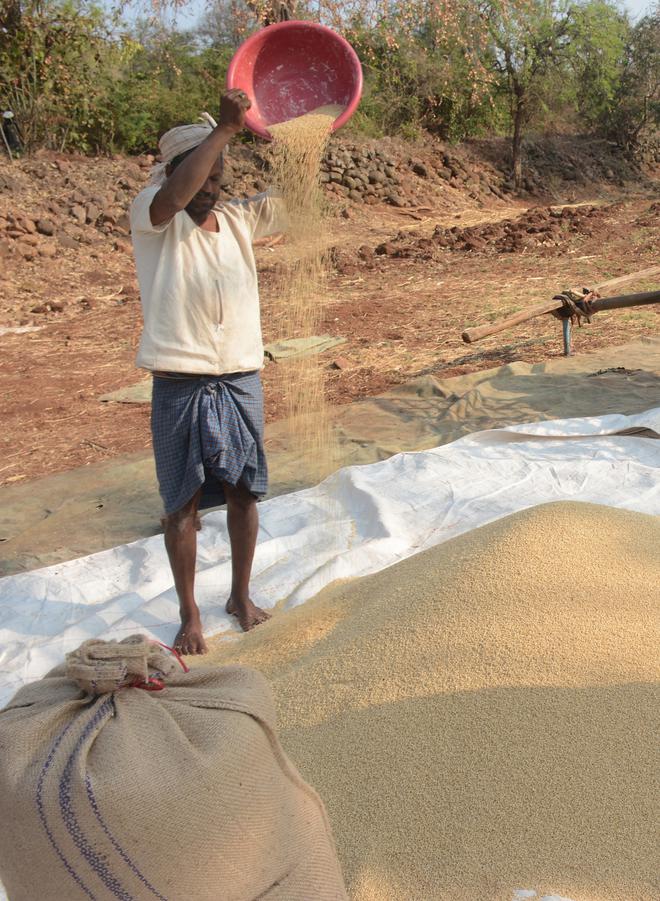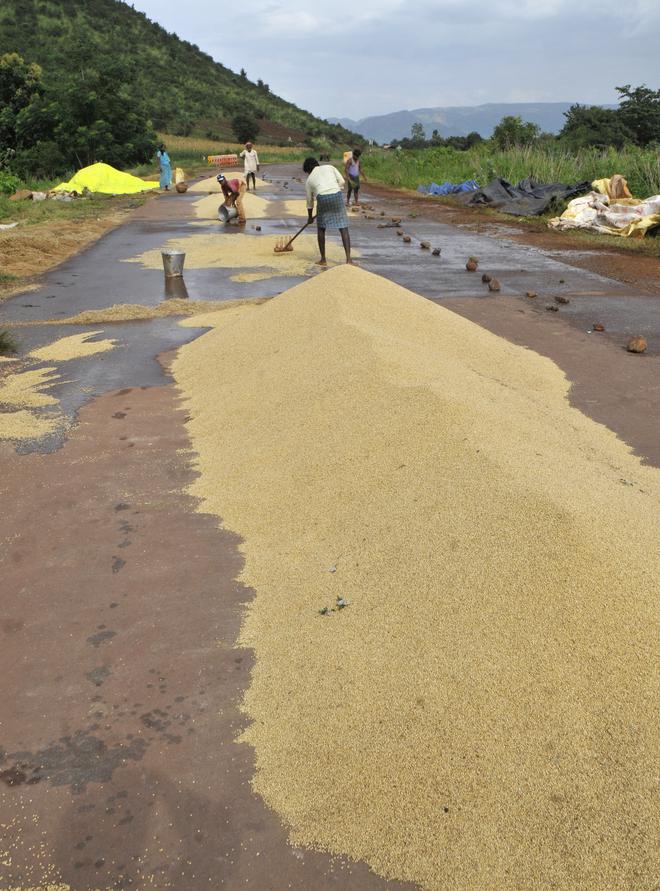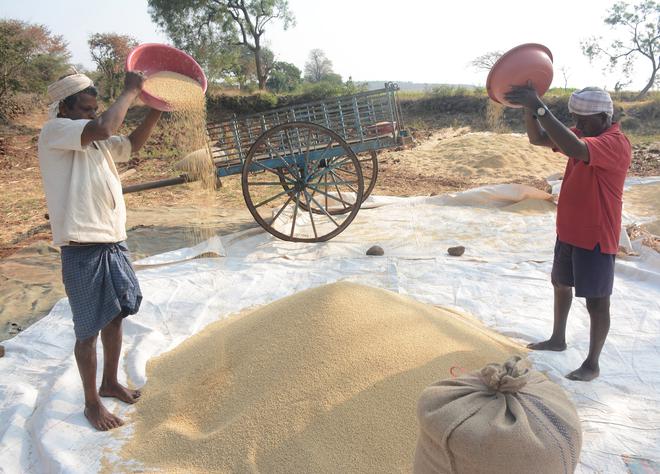Praveen Hebballi, who cultivates a small patch of land near Betasuru in Belagavi district in north Karnataka, is a farmer with a difference. The young farmer has been growing multiple crops with the intention of preserving native varieties. His farm has scores of foxtail millet and Jowar varieties. “I was able to procure seeds of around 60 jowar varieties, of which around 45 germinated,” he says.
He works with various agencies like the Indian Institute of Millet Research, University of Agriculture Sciences, Dharwad, Sahaja Samruddha, an organic farmers association and Revitalising Rainfed Agriculture Network.
Sadly, he is among the breed of Jowar farmers who seem to be vanishing. Though the great millet is the staple of most families in northern Karnataka, area under the crop is reducing.
“When I was growing up, there were jowar fields everywhere. But now they are hard to find. At least half the farmers in the village have given up cultivation of the . They may keep a few rows for self use as food grain for their families and fodder for the few cattle heads at home,’‘ said Hebballi.

Consistent fall
The area under jowar in Karnataka in 1959-60 was 28.86 lakh hectares. It has reduced to just around six lakh hectares in 2022-23. The production has reduced from 12 lakh hectares in 1960 to around seven lakh hectares in 2023.
The fall has been drastic in the last few years. In 2017, farmers grew jowar on 11 lakh hectares. But it dropped to 7 lakh hectares in 2022. Even in predominantly jowar growing districts like Vijayapura, the acreage has been halved. It reduced to 65,000 hectares in 2023, from around 1.5 lakh hectares in 2017.
The only saving grace is that the productivity has increased three times, to 1.2 tonnes per hectares from just 4 quintals per hectares in six decades. This is due to the research and development efforts of farm scientists over the years.
Reasons for the reduced coverage
A long pending issue is that of lower Minimum Support Price (MSP) for jowar. The current MSP is around ₹3185 for hybrid used as fodder and ₹3225 for Mal Dandi jowar or bili jola used as food grain. This translates to around ₹31 per kg for hybrid and ₹ 32 for Mal Dandi varieties. This is around half of the market prices of around ₹40 per kg of hybrid and ₹70 per kg for Mal Dandi.
However, the market prices witness large fluctuations. In one year, these prices have changed from ₹2000 per quintal during harvest and ₹6500 per quintal during sowing.
Scientists working with jowar farmers have observed some other trends too.
Shreeshail Karabhantanal, principal scientist at the regional agriculture research station in Vijayapura, lists the reasons for the shift to other crops, “Area under Pigeon pea (red gram) is increasing due to almost complete mechanization from sowing to harvest including plant protection measures, while there is no mechanization in sorghum production. Due to the expansion of the area under irrigation, crops like sugarcane, chilli and even new crops like Ajwan or caraway are increasingly sown. They also have an established market, making them more attractive. Most sugar factories either carry out harvest operations or pay the farmers for it. Such facilities are not available for jowar as there are no jowar-based food processing industries in the region. Only recently, companies like Parle are introducing Nutritional biscuits containing Jowar flour, under their millet range,’‘ Dr. Karabhantanal said.
Labour shortage
Farmers say the main problem is low prices and labour shortage. “Jowar has been consistently fetching lower prices than other crops. The low yield adds to the woes of farmers. We have been demanding higher MSP and compulsory market intervention by the government. But our pleas have fallen on deaf years,’‘ says Sidagouda Modagi, Krishik Samaj leader said.
“The other major issue is labour shortage. Most of the work on a jowar farm is manual and farmers are not getting workers for the wages they offer,’‘ he said.
“Jowar farming is seen as highly labour intensive. Scarcity of labour during the harvesting period is holding back farmers from sowing it. The large fluctuations in market price and solicitation by agents of sugar factories who offer an improved variety of seeds and saplings and the assured buy back, makes farmers opt for sugarcane,’‘ he further added.

The anomalous behaviour of the consumer
Jowar is the major food crop in the seven districts of Kalyan Karnataka and five districts of Kittur Karnataka. The variety used as a food grain is called Mal Dandi, as it was traditionally grown along the Dhoni river in the undivided Vijayapura district. All the other varieties, are referred by the general term - hybrid. These are grown only for fodder or fire wood.
“Home makers prefer the Mal Dandi because of the taste of the rotis. The hybrid jowar flour does not produce tasty rotis. I have never stocked hybrid jowar,’‘ Rohan Hanje says kirana shop owner in Belagavi.
Scientists, however, say there is no essential difference between the two varieties. “I think it is the perception that matters rather than the taste,’‘ said B.D. Biradar, senior sorghum breeder from UAS Dharwad. “Efforts of extension workers in convincing consumers that the two are not different have not been very successful,’‘ he said.
There is a huge difference in the productivity of the two varieties. While a farmer can get only around four to six quintals per acre of Mal Dandi, he can harvest up to 50 quintals per acre of hybrid jowar.
The food basket model solution
While farmers have been demanding higher MSP and universal market intervention, activists seek sustained state support in other forms.
“We have argued that the State Government should adopt a food basket model of public distribution system, other than the distribution of rice and a few other chosen materials to poor families,’‘ said Abhay Kumar of Grameena Koolikarara Sangha. According to him, the food basket refers to a package of food grains and other materials that are routinely consumed as staple by residents of the region. This means that the people of northern Karnataka should get jowar, southerners Ragi and the coastal residents should get par boiled rice. Successive governments have been proposing this. But there has been no effort at effective implementation,’‘ he said. He feels that procurement of jowar, will gradually increase the area under cultivation.
“Secondly, the government should promote local agri-based industries by procuring and supplying ground nut oil, rather than palm oil and at least one of the lentils, red gram, green gram or black gram,’‘ Kumar said. “Now that the state government has introduced Ragi gruel in mid day meals, ragi farmers are bound to get fairer prices,’‘ he said.
Shivaleela Misale of the Swabhimani Shetkari Sanghatan adds to this recommendation by saying, “The government should buy farm produce at the village levels at legally assured prices. If the department of agriculture can sell us seeds and fertilisers through the Raitha Samparka kendras or by opening temporary outlets in every village, why can it not buy from us?’‘
“There is renewed interest in sorghum in the West. But sadly, we are letting it vanish before our own eyes,’‘ says U.S.A.- trained bio technologist Veerendra Patil.

“Jowar crop is a friend of the farmer. It not only feeds his family, but also his cattle. It needs little water and is resistant to drought and vagaries of the climate. The cost of cultivation is lower compared to other crops. We should make all the efforts to preserve it,’‘ Dr. Patil said.
“Food scientists in the U.S.A. and Europe are promoting sorghum as it is among the few grains that are gluten and lectin free. Sorghum is high in fibre, antioxidants, protein, and minerals like calcium, phosphorus, magnesium, potassium, and iron. Our forefathers knew this, without any scientific data available to them. But we are oblivious to the data before us,’‘ he said.
He also advocates cultivation of sweet sorghum to be used as a fodder crop, as it has more energy. Some private companies have tried to produce multi cut sweet sorghum to harvest grains and the stems for green fodder and fuel alcohol. However, they have not been completely successful, he said.
The government of India, in coordination with state governments is conducting research on hybrid and native sorghum varieties.
All-India Coordinated Research Project on Sorghum (AICRP on Sorghum) was set up in 1969 . It is now head quartered in the Indian Institute for Millet Research in Hyderabad. It has 21 centres in 11 jowar growing states that are governed by state agriculture universities. Four of these are in Karnataka - Kalaburagi, Vijayapura, Dharwad, and Chamaraj Nagar. The centres in Vijayapura and Dharwad have introduced new Mal Dandi and hybrid varieties of jowar.







